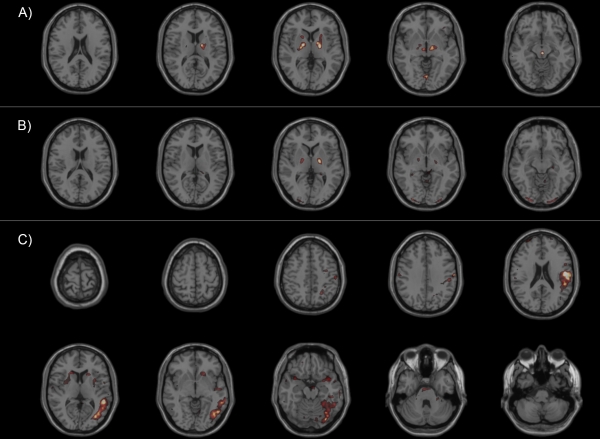Session Information
Date: Wednesday, June 22, 2016
Session Title: Neuroimaging (non-PD)
Session Time: 12:00pm-1:30pm
Location: Exhibit Hall located in Hall B, Level 2
Objective: To explore the potential of [F-18]-AV-1451 PET as a diagnostic tool in Parkinson plus syndromes.
Background: Clinically, atypical Parkinson syndromes are often difficult to separate from idiopathic Parkinson’s disease (iPD). However, there are marked differences in terms of underlying pathology and treatment response. Corticobasal syndrome (CBS) and progressive supranuclear palsy (PSP) are associated with pathological intracellular accumulation of tau protein, whereas the underlying pathology in multiple system atrophy (MSA) and iPD are not associated with tau pathology. [F-18]-AV-1451 (f.k.a. T807) is a PET tracer that binds to intracellular tau depositions. Here, we asses in vivo [F-18]-AV-1451 uptake in several cases of Parkinson syndromes and evaluate the spatial distribution of tau protein accumulations in cortical and subcortical areas by comparison to a cohort of healthy controls.
Methods: In a cohort of 13 patients with Parkinson syndromes (6 PSP, 4 CBS, 2 iPD, 1 cerebellar type MSA), we performed [F-18]-AV-1451 PET. PET data was normalized to MNI space using SPM. We created SUV-Ratio (SUVR) images by intensity normalization to the cerebellum. PETs of a cohort of 19 HC were processed equally. For each patient a 3D dataset was calculated containing the voxelwise Z-transformed deviation of the individual’s PET from the mean [F-18]-AV-1451 uptake in the group of healthy controls.
Results: In comparison to the cohort of healthy controls, all patients with PSP showed increased uptake in the dorsal pallidum and/or midbrain areas. (Figure sections A, B) CBS patients showed a comparatively increased uptake in the basal ganglia and affected cortical areas. (Figure section C). Patients with PD and MSA did not show an increase of uptake in comparison to the cohort of HC. 
Conclusions: CBS and PSP cases clearly showed an increase of [F-18]-AV-1451 uptake in affected areas (midbrain, dorsal pallidum in PSP; cortical regions and basal ganglia in CBS). MSA and iPD – not being associated with a tau pathology – indeed did not show an increase of uptake in comparison to a cohort of healthy controls. These findings indicate that [F-18]-AV-1451-PET has great potential in the diagnostic workup of Parkinson syndromes and the differentiation between iPD, MSA, PSP and CBS. A prospective study is needed to substantiate this finding.
To cite this abstract in AMA style:
J. Hammes, G.N. Bischof, K. Giehl, Ö. Onur, A. Drzezga, T. Klockgether, T. van Eimeren. Tau PET in Parkinson syndromes. A new diagnostic tool? [abstract]. Mov Disord. 2016; 31 (suppl 2). https://www.mdsabstracts.org/abstract/tau-pet-in-parkinson-syndromes-a-new-diagnostic-tool/. Accessed December 20, 2025.« Back to 2016 International Congress
MDS Abstracts - https://www.mdsabstracts.org/abstract/tau-pet-in-parkinson-syndromes-a-new-diagnostic-tool/
